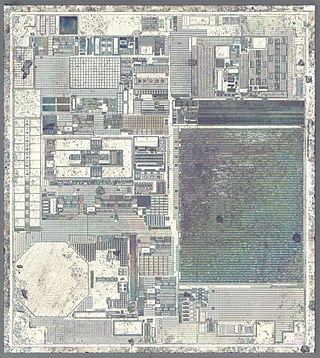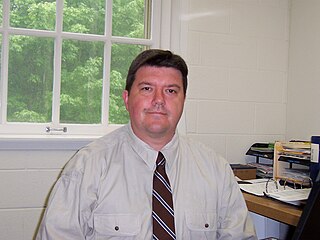Related Research Articles

Nanotechnology was defined by the National Nanotechnology Initiative as the manipulation of matter with at least one dimension sized from 1 to 100 nanometers (nm). At this scale, commonly known as the nanoscale, surface area and quantum mechanical effects become important in describing properties of matter. The definition of nanotechnology is inclusive of all types of research and technologies that deal with these special properties. It is therefore common to see the plural form "nanotechnologies" as well as "nanoscale technologies" to refer to the broad range of research and applications whose common trait is size. An earlier description of nanotechnology referred to the particular technological goal of precisely manipulating atoms and molecules for fabrication of macroscale products, also now referred to as molecular nanotechnology.

The Molecular Foundry is a nanoscience user facility located at the Lawrence Berkeley National Laboratory in Berkeley, California, and is one of five Nanoscale Science Research Centers sponsored by the United States Department of Energy.

Sumio Iijima is a Japanese physicist and inventor, often cited as the inventor of carbon nanotubes. Although carbon nanotubes had been observed prior to his "invention", Iijima's 1991 paper generated unprecedented interest in the carbon nanostructures and has since fueled intense research in the area of nanotechnology.

Nanomaterials describe, in principle, materials of which a single unit is sized between 1 and 100 nm.

Nanoelectromechanical systems (NEMS) are a class of devices integrating electrical and mechanical functionality on the nanoscale. NEMS form the next logical miniaturization step from so-called microelectromechanical systems, or MEMS devices. NEMS typically integrate transistor-like nanoelectronics with mechanical actuators, pumps, or motors, and may thereby form physical, biological, and chemical sensors. The name derives from typical device dimensions in the nanometer range, leading to low mass, high mechanical resonance frequencies, potentially large quantum mechanical effects such as zero point motion, and a high surface-to-volume ratio useful for surface-based sensing mechanisms. Applications include accelerometers and sensors to detect chemical substances in the air.

The Department of Materials at the University of Oxford, England was founded in the 1950s as the Department of Metallurgy, by William Hume-Rothery, who was a reader in Oxford's Department of Inorganic Chemistry. It is part of the university's Mathematical, Physical and Life Sciences Division

Nanochemistry is an emerging sub-discipline of the chemical and material sciences that deals with the development of new methods for creating nanoscale materials. The term "nanochemistry" was first used by Ozin in 1992 as 'the uses of chemical synthesis to reproducibly afford nanomaterials from the atom "up", contrary to the nanoengineering and nanophysics approach that operates from the bulk "down"'. Nanochemistry focuses on solid-state chemistry that emphasizes synthesis of building blocks that are dependent on size, surface, shape, and defect properties, rather than the actual production of matter. Atomic and molecular properties mainly deal with the degrees of freedom of atoms in the periodic table. However, nanochemistry introduced other degrees of freedom that controls material's behaviors by transformation into solutions. Nanoscale objects exhibit novel material properties, largely as a consequence of their finite small size. Several chemical modifications on nanometer-scaled structures approve size dependent effects.

A Stone–Wales defect is a crystallographic defect that involves the change of connectivity of two π-bonded carbon atoms, leading to their rotation by 90° with respect to the midpoint of their bond. The reaction commonly involves conversion between a naphthalene-like structure into a fulvalene-like structure, that is, two rings that share an edge vs two separate rings that have vertices bonded to each other.

Nanometrology is a subfield of metrology, concerned with the science of measurement at the nanoscale level. Nanometrology has a crucial role in order to produce nanomaterials and devices with a high degree of accuracy and reliability in nanomanufacturing.
The following outline is provided as an overview of and topical guide to nanotechnology:

Nanomechanics is a branch of nanoscience studying fundamental mechanical properties of physical systems at the nanometer scale. Nanomechanics has emerged on the crossroads of biophysics, classical mechanics, solid-state physics, statistical mechanics, materials science, and quantum chemistry. As an area of nanoscience, nanomechanics provides a scientific foundation of nanotechnology.

David Carroll is a U.S. physicist, materials scientist and nanotechnologist, Fellow of the American Physical Society, and director of the Center for Nanotechnology and Molecular Materials at Wake Forest University. He has contributed to the field of nanoscience and nanotechnology through his work in nanoengineered cancer therapeutics, nanocomposite-based display and lighting technologies, high efficiency nanocomposite photovoltaics and thermo/piezo-electric generators.
Timothy S. Fisher is an American educator, engineer and expert in the application of nanotechnologies. He is a former professor of mechanical engineering at the School of Mechanical Engineering, Purdue University and Director, Nanoscale Transport Research Group-Purdue University. He currently teaches at the University of California, Los Angeles. He took his Bachelor of Science and doctorate at Cornell University in 1991 and 1998, respectively. Fisher became the chair of mechanical and aerospace engineering department at University of California, Los Angeles, starting July 1, 2018.
The applications of nanotechnology, commonly incorporate industrial, medicinal, and energy uses. These include more durable construction materials, therapeutic drug delivery, and higher density hydrogen fuel cells that are environmentally friendly. Being that nanoparticles and nanodevices are highly versatile through modification of their physiochemical properties, they have found uses in nanoscale electronics, cancer treatments, vaccines, hydrogen fuel cells, and nanographene batteries.
Alan T. Charlie Johnson is an American physicist, professor in physics and astronomy at the University of Pennsylvania, and was the director of the Nano/Bio Interface Center at the University of Pennsylvania (2014-2017).

Nicole Grobert FRSC FYAE is a German-British materials chemist. She is a professor of nanomaterials at the Department of Materials at the University of Oxford, fellow of Corpus Christi College, Oxford, and a Royal Society industry fellow at Williams Advanced Engineering. Grobert is the chair of the European Commission's Group of Chief Scientific Advisors.

Andrea Carlo Ferrari is a professor of nanotechnology at the University of Cambridge.
Elisa Riedo is a physicist and researcher known for her contributions in condensed matter physics, nanotechnology and engineering. She is the Herman F. Mark Chair Professor of Chemical and Biomolecular Engineering at the New York University Tandon School of Engineering and the director of the picoForce Lab.
Angus Ian KirklandFInstP FRSC FRMS is the JEOL Professor of Electron Microscopy at the Department of Materials, University of Oxford. Professor Kirkland specialises in High-resolution transmission electron microscopy and Scanning transmission electron microscopy.

Samuel David Stranks is a Professor of Optoelectronics in the Department of Chemical Engineering and Biotechnology at the University of Cambridge and a Fellow of Clare College, Cambridge.
References
- 1 2 3 4 T, Thompson J. Michael; Giles, Davies (2007-10-18). Advances In Nanoengineering: Electronics, Materials And Assembly. World Scientific. ISBN 9781908979391.
- ↑ "Caterina Ducati". ieeexplore.ieee.org. Retrieved 2019-09-25.
- ↑ "Dr Caterina Ducati — Energy Research at the University of Cambridge". www.energy.cam.ac.uk. 27 October 2010. Retrieved 2019-09-25.
- ↑ Hofmann, S.; Ducati, C.; Robertson, J.; Kleinsorge, B. (2003-06-30). "Low-temperature growth of carbon nanotubes by plasma-enhanced chemical vapor deposition". Applied Physics Letters. 83 (1): 135–137. Bibcode:2003ApPhL..83..135H. doi:10.1063/1.1589187. ISSN 0003-6951. S2CID 96788742.
- ↑ Chhowalla, M.; Teo, K. B. K.; Ducati, C.; Rupesinghe, N. L.; Amaratunga, G. a. J.; Ferrari, A. C.; Roy, D.; Robertson, J.; Milne, W. I. (2001-10-31). "Growth process conditions of vertically aligned carbon nanotubes using plasma enhanced chemical vapor deposition". Journal of Applied Physics. 90 (10): 5308–5317. Bibcode:2001JAP....90.5308C. doi:10.1063/1.1410322. ISSN 0021-8979.
- ↑ Snaith, Henry J.; Ducati, Caterina (2010-04-14). "SnO2-Based Dye-Sensitized Hybrid Solar Cells Exhibiting Near Unity Absorbed Photon-to-Electron Conversion Efficiency". Nano Letters. 10 (4): 1259–1265. Bibcode:2010NanoL..10.1259S. doi:10.1021/nl903809r. ISSN 1530-6984. PMID 20302336.
- 1 2 "Royal Society | Royal Society". royalsociety.org. Retrieved 2019-09-25.
- ↑ Wineman, Adina (2016-08-07). "Caterina Ducati". www.msm.cam.ac.uk. Retrieved 2019-09-25.
- ↑ "Dr. Caterina Ducati - AcademiaNet". www.academia-net.org. Retrieved 2019-09-25.
- ↑ "Group Prize". www.iop.org. Retrieved 2019-09-26.
- ↑ "Prof Caterina Ducati — Electron Microscopy Group". www.emg.msm.cam.ac.uk. 6 July 2016. Retrieved 2019-09-25.
- ↑ "Dr Cate Ducati wins RMS Medal". www.msm.cam.ac.uk. August 2018. Retrieved 2020-04-20.